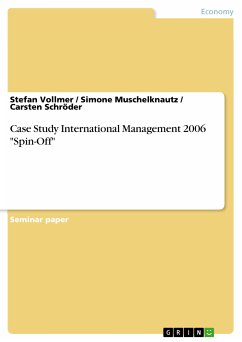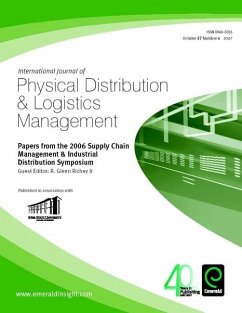
Case Study International Management 2006 "Spin-Off" (eBook, PDF)

PAYBACK Punkte
0 °P sammeln!
Seminar paper from the year 2006 in the subject Business economics - Business Management, Corporate Governance, grade: 1,3, University of Applied Sciences Essen, course: International Management, language: English, abstract: During upswing or boom phases, companies tend to diversify their products and services either by acquisitions or by the foundation of subsidiaries active in different businesses. As the market situation or the overall economic situations change, companies have to adapt their strategy and structure to the current market. If there are changes in the general market situation,...
Seminar paper from the year 2006 in the subject Business economics - Business Management, Corporate Governance, grade: 1,3, University of Applied Sciences Essen, course: International Management, language: English, abstract: During upswing or boom phases, companies tend to diversify their products and services either by acquisitions or by the foundation of subsidiaries active in different businesses. As the market situation or the overall economic situations change, companies have to adapt their strategy and structure to the current market. If there are changes in the general market situation, e.g. by the entry of new competitors, companies might need to restructure to be able to compete. In times of economic downturns, most companies need to restructure due to economic problems and high in-house costs, caused by high complexity and low transparency within the company. Moreover, there seems to be a change in paradigms in the market. Whereas in the 60's (in the US) conglomerates were a prominent way to increase the company value, the current market pays no premium for being a large company. Since the 80's in the US and the late 90's in Western Europe, shareholder value rather is increased by a focused approach on core markets and selling or spinning-off the side-businesses. Major spin-offs were conducted in Western Europe during the recent years, e.g. the spin-off of Infineon from Siemens in 1999 which was followed by a listing of Infineon at the Frankfurt Stock Exchange in 2000, the spin-off of Hypo Real Estate from HypoVereinsbank in 2003, freeing the HypoVereinsbank from their difficult real estate financing business and, against the odds, lead to a successful performance of Hypo Real Estate at the Stock Market7or the spin-off of Lanxess from Bayer in 2005. Looking at the current development of the capital market, European conglomerates seem all to work on their restructuring and on their focus on a certain area8. Recently announced or publicly evaluated transactions include e.g. MAN selling the majority of its printing machine division to Allianz Capital Partners, Linde evaluating the sale of theirfork-lift division, Electrolux envisaging the spin-off and listing of their outdoor division in the company"Husqvarna", to which shareholders consented in April 2006. In the course of this paper, we will evaluate the motives and value drivers of a spin-off with view on the parent company, the spin-off and the capital market including investors and bondholders.
Dieser Download kann aus rechtlichen Gründen nur mit Rechnungsadresse in A, B, BG, CY, CZ, D, DK, EW, E, FIN, F, GR, HR, H, IRL, I, LT, L, LR, M, NL, PL, P, R, S, SLO, SK ausgeliefert werden.













